I recently found this article concerning downsizing and living a more simple life with a Tiny Kitchen. Many of the points made are very appropriate when you are considering one of our mini-kitchens for your smaller multi-task living area.
I’ve added some mini-kitchen images to help explain some of the points the author makes. David Beer, Founder, YesterTec Kitchen Works
Tiny Kitchens
Creating a tiny kitchen is useful whether you live in a large space or a tiny space. If you currently have a large kitchen, creating a “tiny kitchen” is a good place to start living tiny and is also very aesthetically pleasing.
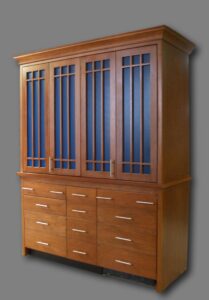
This armoire safely hides a complete kitchen, including the ‘hot’ appliances.
Cluttered, messy kitchens are hard to keep clean and hard to work in, and most of what people keep in their kitchens are not used on a regular basis or perhaps ever at all. Imagine walking into your kitchen and experiencing a zen-like feeling of peace and happily anticipating the preparation of even the most simple of meals.
It’s hard to talk about what you need in your kitchen without talking about what you’re going to cook. The next article, therefore, will be about Tiny Meals. For now, let’s take a look at each area of your kitchen.
Pots, Pans, & Bowls
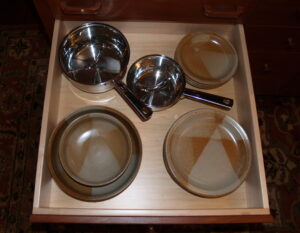
One of the drawers in a mini-kitchen extends all the way out to reveal the dishes and pots and pans that you really need
Instead of looking at your amazing array of kitchen utensils and trying to decide what to keep and what to get rid of, start with nothing and add only the barest minimum. How many frying pans do you need? If you’re single, you only need one. Most of the time I don’t even use a frying pan. One day I realized that the meals I cook in a large frying pan could be cooked in a pot just as easily. When I cook those meals in a frying pan, I frequently spill food over the shallow sides. In the pot, the high sides keep everything safe inside. If you have a family, however, there will be times when you only need a small frying pan and other times when you need a large one. So, two frying pans.
Next up are pots, and the same rule applies here. If you’re single, you only need one. If you have a family, then probably two.
Mixing bowls? Think multiple use. Use Pyrex measuring cups for your mixing bowls. You can get them as large as 8 cups. You can often eliminate another utensil to clean by pouring directly from the measuring cup. I’m thinking specifically of pancake batter and gravy, but there must be tons of other uses.
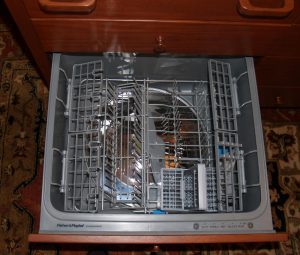
Some people store all dishes and utensils in the single drawer dishwasher then after each meal, the used dishes go back in and all are washed again. Now that is extreme, but it works for some.
Dishes
One set per person. One plate, one bowl, one glass, one spoon, one fork, and one knife. Mostly I use just a bowl and a spoon. A sandwich in a bowl tastes exactly the same as one on a plate. Most food can be eaten in a bowl. Want to make sure you don’t waste your food? Add a little water to the bowl when you’re done and drink it. Sound crazy or is it just another idea we’re not yet familiar with?
Appliances
Kitchen appliances can be a tough issue. On one hand, none of them are truly essential, but they can free us up to live more simply. When possible, try to combine uses and eliminate appliances we’re only led to believe are necessary. For example, instead of a toaster, why not a toaster oven? I often find myself wanting to bake something small, but it’s too much of a waste to heat up a large oven for one small item such as a pot pie or a veggie burger. If you’re preparing only tiny meals, you don’t even need a standard oven and range. A toaster oven works perfectly fine and a hot plate replaces the range. So out goes another appliance: I eliminated the need for a toaster.
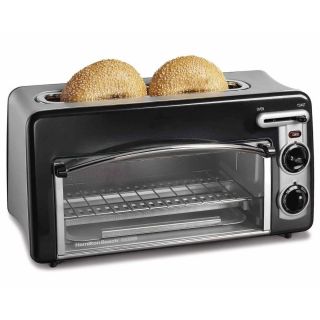
Combining functions in small appliances can save a lot of counter space. This is ToastStation by Hamilton Beech.
Which appliances to keep are a matter of preference. If you use the appliance frequently and can’t easily replace or eliminate it, then by all means keep it. Perhaps you can change your taste preferences to eliminate the need for that appliance. Freshly ground coffee tastes heavenly, but when I decided that pre-ground coffee was just fine, I got rid of another appliance. Then I got rid of the need for a coffee pot altogether by purchasing a French press travel mug. I simply put the coffee grounds directly into the travel mug, add hot water, and I’m good to go.
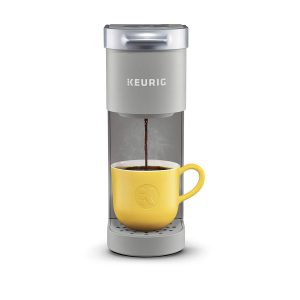
What more do you need than this single serve Keurig coffee maker?
Do you really need a mixer? Remember that these are relatively new devices, like all appliances, and cooks used to mix with nothing more than a wooden spoon. Juicer? Food processor? Microwave? Blender? Slow cooker? If the appliance is rarely used or can be replaced by something as simple as a wooden spoon or a sharp knife, get rid of it. If you use the appliance several times per week, keep it. Don’t anguish over your decisions; make them and move on. You can always pack away an appliance you realize is rarely used.
Kitchen Gadgets
It’s far too easy to buy far too many kitchen gadgets and utensils. Most of them are completely unnecessary unless you use them at several times per week. Do you really need a garlic press you only use once per week when you can just as easily chop the garlic with a knife? My current list of must-have kitchen utensils, other than my knife, is one spoon, the same one I eat with. Again, if you use an item several times per week, keep it. Everyone’s cooking habits are different, so don’t try to fit your square-peg self into a circular hole.
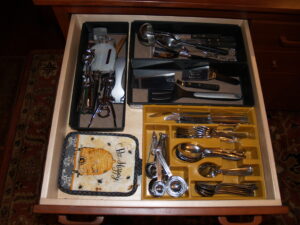
If you are using your mini-kitchen for everyday cooking, it needs space for utensils of all sorts, but pare it down to those you must have. Leave the cute ones on the shopping channel.
Knives
You only need one kitchen knife: a chef’s knife. If you often slice bread, get a bread knife. You will find that the one utensil you use more than any other is your knife. Need to zest a little orange or lemon peel? Scrape it with a knife. Think the food processor you packed away would be perfect for the job at hand? Chop away with your knife. Stop thinking that you need to have a special gadget or tool for every little job.
Storage Containers
How easily these multiply. All of those little plastic containers that we buy our food in seem like the perfect storage containers. I say no to those for a couple of reasons. First, it’s impossible to tell what’s in the container without opening it. One day I opened the refrigerator and saw that I had five yogurt containers and only one actually contained yogurt. I tried to solve this problem by buying masking tape and a Sharpie and labeling the containers, but this takes a certain amount of discipline and when you’re cleaning up after a meal, tidy organizational habits are often missing.
Second, most plastic food containers are made from soft plastic, and I worry about what leaches into and out of the plastic. Most plastic storage containers are made from harder and higher quality plastic and are much safer to use. Also, they’re usually clear so you can see the contents with a quick glance. Maybe. Some of us create mixtures in the kitchen that have an ingredient content difficult to ascertain even while we’re cooking them, let alone a day or two later. Even better than plastic storage containers, however, are canning jars. Get the half-pint jelly jars, the pint-size, and the quart-size jars, all with wide mouths. I also bought several half-gallon and gallon-size jars that I use for storing rice, beans, lentils, flour, and so on. They last forever and you don’t have to worry about leaching. And the lids are interchangeable!
Throwing Away vs. Storing
In the beginning, don’t get rid of your excess kitchen supplies. It’s hard to decide for sure what you do or do not need. My advice with any minimizing project is to set aside the few items you’re positive you need and put the others in a box or bin and hide it away some place. If you do need one of those items you packed away, dig it out and don’t feel bad about it.
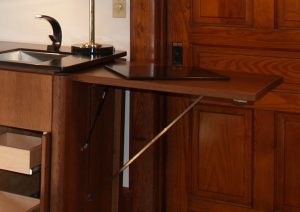
Here the side panel rises flawlessly out of the side of a mini kitchen and can be the only only eating table in the room or just extra counter space.
Quality
Since you’re drastically reducing the number of kitchen supplies you have, you should buy the best you can afford. If you only own a few items, every item should be high quality. Especially don’t skimp on quality when it comes to knives. Your chef’s knife is the single most important tool you have in your kitchen, so get the very best you can afford. Try to spend at least $30. I have my eyes on one that costs $150, and it will be worth every penny.
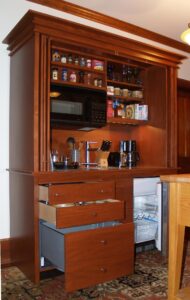
A mini-kitchen keeps most things you need close at hand. If you have another closet for bulk items, it will save you trips to the store.
As with most of our life, transitioning to a tiny kitchen is just that, a transition, a path, a journey. Take your time and travel as slowly as you need to. Start with one area and reduce your possessions mindfully. Although you feel good when you have accomplished your goal, how sad to not enjoy the entire process. This path should be fun. Enjoy the game. Again, start by putting everything into storage and keeping less than you think you might actually need. Spend a couple of days with nothing more than a spoon, a cup, a knife, and a small pot. You can cook with the spoon and pot and you can eat from the pot with the spoon, so what more do you really need? Enjoy your journey to a tiny kitchen while I go put a few more items in storage….








